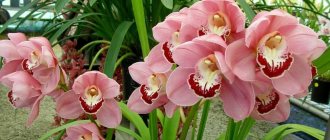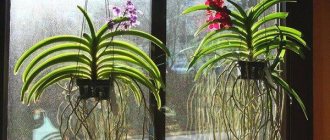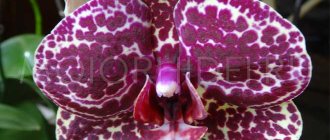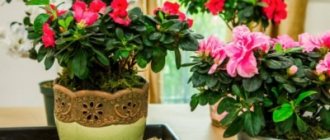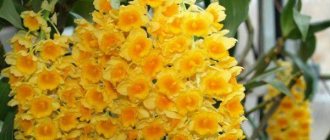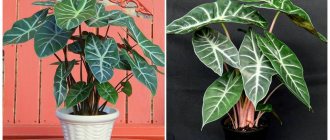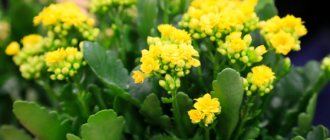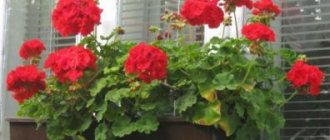Spring is coming, March 8th. We remembered that any woman would not mind receiving a beautiful flower in a pot as a gift. A wonderful choice would be the extraordinary beauty of the Vanda orchid. Vanda is deservedly considered one of the most luxurious types of orchids. It is distinguished not only by the exquisite beauty of its flowers, but also by its powerful root system, which practically does not need any soil, since it can receive moisture and nutrients even from the air. When kept at home, this beauty is quite capricious; she requires a lot of attention and love. In this article we will tell you in detail about her character, preferences, and teach you how to care for Wanda at home in order to minimize possible problems.
Popular species to care for at home
Wanda Rothschild
The most popular among flower growers are five varieties of the Vanda orchid:
- Blue. It grows up to 1 m high. It has a well-developed root system. The diameter of lavender flowers reaches up to 10 cm.
- Tricolor. Reaches a height of up to 2 m. The color of the flowers is white or cream with spotting.
- Sandera. The leaves grow up to 40 cm in length. The flowers have soft pink petals with a white border.
- Rothschild. The hybrid flower was the result of crossing the blue Vanda and Sandera. The color of the flowers is from blue to dark blue.
- Rolled. In nature it reaches a height of up to 3 meters. It has long (up to 20 cm) and narrow (3 cm) leaves.
For more information about all types of this orchid, see here.
Popular varieties of vanda orchid
The Vanda orchid has many different varieties, each of which has its own size and color of flowers.
| Variety | Description | Flower | Leaves |
| Blue | Straight stem 1 m in height. Peduncle - 80 cm. | 7-12 purple-white. The diameter is 10 cm. The lip is small, almost invisible. Pleasant aroma. | Oval, elongated, arranged tightly. |
| Tricolor | Can reach 1.5 m. | 7 cm in size, up to 10 variegated flowers in total. Wavy shape. White petals with red spots, pink lip. | Rough, about 40 cm. |
| Sandera | 60-120 cm in height. Peduncles reach 50 cm. | 5-10 pieces, yellow, pink or white. Multicolor variegated petals with double plain lip. | They bifurcate towards the end. |
| Chess | 70-100 cm. | 12 large flowers, usually beige or brown. The lip is bright purple. Pleasant aroma. | Greenish, hide a long stem. |
| Valkovataya | 150-200 cm. | 5-6 pinkish buds 12 cm in diameter. There are many red spots on the purple lip, with a burgundy tint at the base. | Cylindrical, densely located along the entire length of the stem. |
| Norbert Alfonso | 80-90 cm. Medium peduncles. | 10-15 large, petals are colored pink. The lip is burgundy, wrapped in a kind of tube. | Rounded, pointed. |
| Javier | 35-50 cm. The stem is low. | 10-12 medium flowers. The lip and petals are snow-white, which is exclusive to the Vanda genus. | Dense rows of dark green leaves along the edges. |
| Rothschild | 80-100 cm. Peduncles up to 60 cm. | 15-18 pieces, Blue purple petals with a dark short lip. Diameter - 6 cm. | Rough, the tips bifurcate, like Sandera's. |
Choice at time of purchase
Every novice gardener wants to buy a Vandu orchid for their collection. However, more experienced ones advise not to buy it if there is no practice in growing other types of orchids.
If you decide to buy Wanda, then contact a specialized store. When purchasing, check:
- Leaves. Must have a uniform green color, without blackening, pinpoint spots, mechanical damage or signs of wilting. They feel elastic and smooth to the touch.
- Roots. Excessively dry or soft ones indicate improper care and the beginning of decay. The color of the roots is uniform, without any spots.
- General condition of the plant. There should be no obvious signs of the presence of pests or diseases. The optimal age of a flower to buy is more than two years.
IMPORTANT: It is recommended to purchase a flower that was grown in local climatic conditions. Imported from other countries do not acclimatize well.
History, origin and place of residence
Vanda's place of origin is Tropical Asia, Australia and the Philippines. In ancient India, where the name orchid comes from, the leaves of the flower were used to prepare certain medicines.
Now these plants are common in continental Southwest Asia, Indonesia, and northern Australia. This type of orchid was named by Sir William Jones in 1795.
Vanda has great value and is easy to cross, so there are many hybrids of it.
Growing in a pot, glass and without soil
Under natural conditions, the Vanda orchid grows in a suspended state without soil.
Therefore, it is not necessary to use a substrate for growing at home. If this confuses the gardener, then you can purchase a regular substrate intended for orchids in the store. It is poured into a wide bowl and placed in a flowerpot with many holes on the sides and bottom; they provide ventilation to the roots. For growing Vanda, ordinary pots are not used. Nets, wire pots, wicker baskets, and glass flasks are suitable for it.
Orchid roots are so sensitive to excess moisture that they can quickly rot in any substrate.
If Vanda is placed in a glass vase without a substrate so that its roots are inside and the ground part is outside, then it will feel good and grow. This way the flower receives enough light. It is recommended to use a container with a wide bottom and a narrow top. A vase in the shape of a glass, cylinder, or ball looks good.
Growing Vanda in a wicker basket is the most common method among gardeners. This way the root system does not rot from excessive moisture and receives enough light and air.
Conditions of detention
Since this variety comes from hot latitudes, the maintenance conditions must be appropriate:
- the air temperature should be between 16-29 degrees; if the room is more than 30 degrees, the plant may die;
- humidity should be within 80% (this figure can be maintained by regularly spraying the plant);
- Vanda does not require any substrate ; its root system must be constantly open. As a last resort, you can use oak bark as in the case of Phalaenopsis;
- This plant is very light-loving , but it is worth limiting direct sunlight. It is especially important to maintain proper lighting in winter; in summer, the orchid can be placed on the balcony;
- When planting in the ground, water the plant, just like other varieties of orchids: as the substrate dries.
Vanda's root system can be left open.
Important! The temperature to maintain this flower should be the same throughout the year.
Vanda does not have periods of rest or active growth . Only during flowering can the growth of its leaves stop. Strong changes in temperature can provoke a lot of diseases for the flower. It is best to keep Vanda open (without adding soil).
How to water in a basket and glass vase?
Watering the Vanda orchid has its own characteristics depending on the container in which it is planted.
Growing in a wicker basket obliges the owners to irrigate the roots often: in the summer - every day, in the winter - once every three days. If the flower grows in a plastic pot with holes and substrate, then watering is carried out only when the soil is completely dry.
Growing in a glass flask:
- Pour water down the side of the vessel until air bubbles stop rising. This indicates that the flower has absorbed as much water as possible into the roots.
- Excess water is carefully drained after 15–20 minutes.
- Watering is carried out twice a week.
In the video you can see how to care for the Vanda orchid at home. It describes in detail how to water and maintain in a glass vase:
Vanda flowering
Care during flowering
Vanda does not have a clearly defined dormant period, and it can bloom all year round, especially in the spring and summer, since at this time there is long daylight. On average, flowering lasts 6-8 weeks, but can sometimes last up to three months. The vanda flower is an amazing creation of nature, and if you have seen it once, you will want to see it again. By observing all agrotechnical requirements for flower care, you have the right to count on the fact that the vanda will bloom annually and even more than once.
If you're concerned that your orchid isn't blooming, it could be that it's not getting enough light, or the difference between day and night temperatures is less than eight degrees, or maybe you've overfed the orchid with nitrogen.
Vanda after flowering
When the vanda orchid has finished blooming, cut off the flower stalks and keep the roots less moist by soaking the roots in a container of warm water once a week. Spraying should also be stopped for a while. If you have the opportunity, take the vanda into the garden, hang it on a tree or place it on the balcony, on the terrace, where the conditions suit it, and care for it as before flowering. Fresh air will definitely do her good.
Reproduction
Wanda rarely has side shoots. Therefore, flower propagation is carried out by cuttings and children.
How to propagate:
- Cut off the top of the flower along with the aerial roots. Place the resulting cuttings in a growth stimulator solution. Then transplant it into a new glass container.
- After cutting off the top, new lateral shoots grow on the trunk - “babies”. When the sprouts reach at least 5 cm and their own roots appear, they can be separated from the mother flower.
- The baby is placed in a pot with a substrate and greenhouse conditions with high humidity (at least 80–85%) are created.
Conditions for seasonal plant care
There are some seasonal patterns that ensure the existence of the species. In captivity, the plant will lose its decorative appearance, refuse to bloom and die if its needs are neglected. Vanda orchids are the most demanding in terms of maintenance conditions. When breeding at home, you should start with hybrid varieties; they are better adapted to indoor conditions.
How to care depending on the season and avoid sunburn - table
| Season | Lighting | Humidity | Temperature |
| Spring | Bright lighting is required, but the sun's rays must be avoided; their exposure causes burns on the leaves. Daylight hours are at least 12 hours. It is best to place it on western and eastern windows. The north window is not suitable. | Vanda requires high humidity - not lower than 80%, especially at elevated air temperatures. Spraying daily, and sometimes 2-3 times a day, will help avoid problems. Make sure that when moistening, water does not collect in the axils of the leaves. If the air temperature is below 18°C, do not spray the leaves. | Vanda is a heat-loving plant. Ideal conditions are achieved at 22 - 28°C. The maximum threshold can reach 40°C, and the minimum 8 - 10°C. The night temperature should differ from the day temperature; it should be lowered to 14°C. The orchid loves ventilated rooms, but it needs to be protected from drafts . |
| Summer | |||
| Autumn | In winter, you can place the plant on a south window. If Wanda remains on the east window, she will need additional lighting. | ||
| Winter |
Transfer
Frequent replanting of the flower is not required, since it is grown hanging in a basket or vase.
Replanting is carried out only if the root container has become small, for example after purchasing it in a store or when the substrate needs to be replaced.
How to transplant:
- moisten the root system so that the substrate comes off easily;
- inspect hanging roots and remove dry, damaged or soft ones;
- Roll the long roots into a ring and place in a new pot.
Requirements for planting and transplanting
For planting, it is better to choose a plastic container with good drainage holes. In addition, the side walls should also have holes, which will improve root aeration. If you choose a ceramic pot, it should be poured, with smooth walls, which will make it easy to remove Vanda when replanting, and have holes at the bottom and sides. Wicker baskets or flowerpots are suitable.
To plant Vanda orchids you need to choose perforated pots
The plastic pot may not be transparent. But for a novice gardener, it is better to choose a transparent container; it is much easier to control the condition of the roots.
In specialized stores you can purchase ready-made substrate for orchids. When making your own mixture, use the following ingredients:
- old pine bark, boiled, dried and crushed;
- sphagnum moss;
- charcoal;
- coarse sand;
- crushed cork;
- To improve air and moisture permeability, you can add perlite.
The presence of drainage in the planting container is mandatory!
Healthy plants are replanted every 2–3 years, after flowering. The purchased Wanda must get used to the new conditions for a week before transplantation.
An emergency transplant is required if:
- the substrate has become compacted and the roots do not receive air;
- the moisture-intensive composition does not dry out for a long time;
- incorrect composition;
- the roots are too deep;
- The roots are rotting.
You can buy the substrate for planting or prepare it yourself
Step-by-step transplant
- Carefully remove Wanda from the old pot. If the roots are in the transport substrate, carefully remove it.
- Inspect the roots and rinse in warm water. Remove the damaged ones, and treat the cut areas or wounds with activated carbon.
- Place drainage in a new container and new soil mixture on top.
- Place the orchid in a new pot without damaging the roots. Add the rest of the mixture from the sides. Do not compact!
- If all the roots do not fit in the container, you can leave some outside.
- For the first 5 days, do not water, but only spray the leaves.
Most often, Vanda is grown not in a substrate, but with open roots - in baskets, lattice containers or on a piece of bark. In this case, it does not need replanting; attention should be paid to the root system, moisturizing and feeding it in time, as well as removing dried roots.
When growing Vanda in lattice containers, you need to pay more attention to the roots
Diseases and pests
The flower is susceptible to various diseases if the rules of care and maintenance are violated. Diseases such as fusarium, fungus, bacterial rot, and viruses occur.
Pests attacking the orchid:
- thrips;
- spider mite;
- scale insect
Culture
When I write “Vanda,” I mean not only Vanda, but also related orchids, since most of them can be cultivated in similar conditions.
Plant selection
An important point if you want to have success with vandas and related plants is choosing the right specimen. Try to find a supplier who has grown their plants in our climate for at least a couple of years. A plant from a greenhouse in Northern Europe will acclimate much more easily on your windowsill than if it came directly from a supplier in, for example, Thailand. Plants imported from Asian countries will take one to two years to acclimatize.
Don't buy unnamed plants because you won't be able to find information about their parents or the growing conditions they prefer. In addition, you will not be able to participate in exhibitions with an unnamed plant. We can only hope that if buyers become more interested in the names of plants, sellers will gradually stop purchasing plants without names.
If you decide to buy your first plant, choose Ascocenda Princess Mikasa! Many clones of this hybrid (Ascocenda Royal Sapphire x Vanda coerulea) flower very easily and easily adapt to window sill conditions. At first, you should always choose hybrids, since they are noticeably easier to grow indoors. Try to find plants that have among their ancestors Vanda Gordon Dillon, Vanda Kasem's Delight, Vanda coerulea, Ascocenda Yip Sum Wah, which are considered successful parents.
Transporting the purchased plant
Buy plants only in the warm season, from May to September, as there is a risk of hypothermia on the way home. No, of course, I’m joking, but it doesn’t hurt to know that Wanda is capable of gradually withering away from the stress she receives. Therefore, make sure that your plant is thoroughly packaged.
Lighting
Vandas and others like them love light, but the type of vanda that suits our climate does not like direct midday sun.
There are three types of vandas: broad-leaved, semi-terete and terete. The first of them is the one that is easiest to grow in our climate; it is this type of vanda that will be discussed further. It has leaves that are flat or slightly V-shaped in cross-section. The terete type has round succulent leaves and requires constant direct sun for abundant flowering; it is difficult to cultivate in our climate. The semi-teret type is a hybrid of the two above.
Most vandas make do with diffused sunlight during the daytime of the year, from May to September. Direct sun at this time does more harm than good. Therefore, a slightly shaded south, south-west or west window with blinds will suit them perfectly.
During the dark seasons no shading is required, but in the darkest months additional lighting may be required. Table 1 shows the number of daylight hours in each month of the year. And, based on the optimal amount of 12 hours of light daily, then from approximately the beginning of October to mid-March, plants need to be illuminated.
| 16,57 | |||
| 1st of February | 8,37 | August 1 | 15,73 |
| February 16 | 9,37 | August 16 | 14,74 |
| March 1 | 10,32 | September 1 | 13,57 |
| March 16 | 11,46 | 16 of September | 12,43 |
| April 1 | 12,69 | October 1 | 11,28 |
| April 16 | 13,82 | October 16 | 10,15 |
| 1st of May | 14,91 | Nov. 1 | 9,00 |
| 16th of May | 15,87 | November 16 | 8,05 |
| June 1st | 16,67 | December 1 | 7,32 |
| June 16 | 17,05 | December 16 | 6,93 |
Table 1. Daylight hours in Helsingborg, southern Sweden
I have additional lighting in only one window at home - 3 fluorescent lamps of 36 watts each, and this works well. Some plants hang without any illumination throughout the dark half of the year, but they also grow and bloom, only they receive less water than the rest.
In the warmest summer months, when the temperature does not drop below +16, it is advisable to grow vandas outside the home. You can acclimate the plants by first placing them in partial shade and then gradually increasing their exposure to light.
The length and color of the leaves will tell you whether the Vanda is receiving the “right” amount of light. For comparison, the leaf color should be medium green, a shade darker than a Granny Smith apple. If the leaf color is dark green, you need to increase the amount of light; if it is light green with a yellowish tint, reduce it.
Another indicator is leaf length. If the last pair of leaves is longer than the penultimate one, it means that the plant received less light than before, if on the contrary, it means more than usual. This, however, does not apply to young plants, but only to fully mature ones.
Temperature
Most vandas like temperatures between 18 and 30 degrees during the day and around 16 degrees at night. They can withstand temperatures up to 35 degrees, provided there is increased air circulation, high humidity and shading. One of the progenitors of most blue vandas is Vanda coerulea, which can tolerate temperatures down to +10 degrees. In places where Vanda coerulea naturally grows, the temperature drops to zero degrees during the winter months, and the orchid can withstand it!
A difference of 8-10 degrees between day and night temperatures promotes flowering. In the summer, when the apartment reaches 30 degrees during the day, and by night the temperature drops to 20-22, this happens naturally. In winter, it is difficult to achieve such a significant temperature difference. A small difference can be achieved by disconnecting the batteries at night.
Watering and substrate
Most of the mistakes in Vanda indoor culture are related to these aspects.
Vandas raised in the light require much more water than is commonly believed. Most plants in this genus require alternating dry and wet cycles for optimal growth. And after trying many different planting materials, pots and baskets, I came up with what works best in my home. I grow most of my bare root vandas (no substrate) in plastic or wood baskets. I do this so that they can be watered daily, and at the same time they have time to dry out by the evening. This way they get more water and fertilizer with minimal risk of rot.
More water = more fertilizer = faster growth = more potential blooms
During the summer months, my vandas take about a 20-minute bath every day. The roots located above the surface of the water are watered with a fairly powerful shower jet until they turn green. Sometimes, especially with new plants that haven't been watered well in the past, you may have to water several times at intervals of a few minutes to get completely green roots. Don't give up: water, water, water until the roots are completely filled with water.
During the dark season, watering must be approached with caution, especially from September to November, when the amount of light decreases sharply. This time of year I only water when the sun is shining, or every 1-2 days.
In our latitudes, due to the low amount of light, vandas and related plants experience a short rest period, so try to correlate watering with the conditions of the dark season.
Fertilizer
If you want to get a healthy plant that blooms well and often, then another important factor is abundant feeding. I use a balanced fertilizer with a 20-20-20 formula. I tried to use the so-called Bloom Boosters with formulas 10-30-20 and 10-50-20, but did not notice a noticeable change in the frequency of flowering.
In the summer, plants are fertilized with each watering with half the recommended dose (which for Peters 20-20-20 is 13 ml/10 liters of water). When the plants are kept outside and the weather is warm, they are also fertilized with the above dose per leaf at each watering. In winter, I fertilize with the same dose of fertilizer after one watering.
How can you tell if your plants have received the right amount of fertilizer? If they grow well, then on the last leaf, in the place where it meets the old leaves, a light strip of young tissue appears. If this strip of new leaf tissue, which has not had time to acquire the “right color” under the influence of sunlight, is about 1 cm wide, then your feeding program is perfect. If it is less than 1 cm, it is necessary to increase either the quantity or frequency of fertilizing. If this strip approaches 2 cm, then it is better to reduce the amount of fertilizer.
Plants that receive little fertilizer do not bloom to their full potential. Plants that receive too much fertilizer become weak and their tops become soft, to the point of bending.
Air humidity
Humidity should be between 50-80%, and it is especially important that it be high at night when the plants are breathing. You can increase the humidity around your plants by placing the pots in a container of water. Take care, however, that the pots and water are not in direct contact.
A more expensive, but also more effective method is a humidifier. There are two types of humidifiers. One of them boils and evaporates water; this type is the most efficient, but consumes a lot of electricity. The second humidifies the air with cold water sprayed by a fan. This type is cheap to operate, but it is undesirable to use tap water in it, since the salts dissolved in it are carried throughout the room. You have to use “osmosis” water or condensate from the drying drum, which is a disadvantage of the device.
Air circulation
Constant air movement is another important success factor. If its circulation is poor, the risk of burning plants standing or hanging near the window increases. The burn does not heal and, since vandas grow monopodially, it persists forever. Another reason to keep the air moving is that pests don't like it.
You can check air circulation by placing candles at different points of the window. Light the candles, turn on the fans and see if the flames flicker on all the candles. Adjust the fans to maximize air circulation. Sometimes this check entails the purchase of additional fans.
Possible problems
The occurrence of various problems when growing Vanda orchids at home is a common occurrence. This is explained by the capriciousness and complexity of maintaining the flower. What to do, if:
- The leaves wither and turn yellow. Reason: the flower is under stress. It can occur if there is a constant draft in the room, an open window, high or low air temperature, lack of fresh air, or lack of nutrients. If the leaves turn yellow and dry, then the plant is being attacked by a mealybug. Eliminate the cause.
- The buds are falling. Reasons: lack of lighting or watering, low air humidity, sudden temperature changes, excess or lack of fertilizers, natural aging. Eliminate the causes.
- The peduncle withers and dies. Reason: dry air in the room or soil in the pot, parasite damage. Remove the flower stalk, increase humidity, start pest control.
What other diseases of orchid leaves are there and how to treat them, read here.
Reanimation of roots if they are dry: how to grow them?
The roots begin to dry out if the air in the room where the orchid is kept is too dry. To eliminate it, it is necessary to water by completely immersing the root system in water and spraying the roots more often.
If this method does not help, and the plant is left without roots, then it is necessary to grow new ones. To do this you need:
- Trim off diseased areas of the roots and secure the remaining stems with wire.
- Hang the flower in the shade with the top down.
- Regularly spray the orchid with universal fertilizer with added sugar in a 1:1 ratio.
- The roots will recover in a few months.
- When it reaches 30 cm, plant it in a pot or glass vase.
In the video you can visually see how to grow the roots of the Vanda orchid:
The Vanda Orchid is an exotic flower that requires additional attention. Compliance with all growing conditions will allow it to bloom twice a year, avoiding diseases and pest infestation. If any changes in appearance appear, carefully examine the flower and eliminate the reasons causing yellowing or falling of leaves and buds.
Description of the plant
The Vanda genus includes more than 50 species of orchids. Basically, these are epiphytic vines of impressive size, that is, they live on the trunks and branches of large trees, which serve as support for them, helping them climb to greater heights, closer to the light. Moisture and nutrients are obtained from the atmosphere and organic residues on the bark and leaves of neighboring trees. But there are also lithophytes growing on stones, and terrestrial species - but they are few. In its natural environment, the height of the plant reaches several meters. Home-grown orchids do not exceed a meter.
Wanda's root system is powerful. Aerial roots of gray-green color do not need soil, absorb moisture from the air and are not afraid of sunburn, since they are covered with a dense layer of dead plant cells with a porous structure.
Vanda's stem has a cylindrical shape. It is densely covered with fleshy, rolled or belt-like leathery leaves, arranged alternately. As the leaves age, they die. The leaf color is light or dark green. The flower does not grow in width, it is not characterized by the formation of pseudobulbs. The growth rate is average, one leaf appears in two months. Peduncles are tall, erect or oblique, they appear at the base of the last well-formed leaf. There can be several flower stalks in one pot.
The inflorescences are loose and racemose. They combine from 2 to 15 large flowers of various colors - from plain white, yellow, red, blue, indigo, purple and brown, to multi-colored and variegated - with specks, streaks, spots. The size of the flowers is impressive - their diameter can reach 15 cm. Interestingly, all the petals are located almost in the same plane. Their edges are usually rounded. When the flower begins to bloom, it has a faded color and small size. But then, every day it increases in size and gains brightness and color saturation.
Flowering of different types and varieties of Vanda can occur at any time of the year and lasts from 1 to 3 months. Under favorable conditions, flowering repeats, sometimes up to three times a year. Some species of this orchid have a very fragrant, pleasant smell, but most bloom without smell.
Orchids in a flask
A flask or bottle (from Latin flasco - “vessel for wine”) is a small container that is used for storing liquids and other substances. In the context of growing orchids, flasks are glass or plastic bottles containing seedlings and juveniles. This container is temporary and is only suitable for germinating seeds and growing seedlings.
Orchids in flasks.
The cost of a bottle of seedlings varies depending on the type of plants inside and their quantity. It can range from several dollars and above, reaching tens and hundreds of dollars.
Advice! You can purchase a “flask” with orchids via the Internet on specialized websites, in stores or directly from breeders.
Advantages and disadvantages
The big advantage of such a purchase is:
- relatively low cost of each individual plant;
- a large number of them;
- the ability to grow a plant that is fully adapted to specific conditions.
Also, sometimes this is the only opportunity to purchase a specimen of a particularly rare species. Purchasing a batch of bottles with orchids is a good way to start a business with the resale of orchids.
Among the disadvantages are the downsides of the advantages. In fact, when placing an order via the Internet, the gardener plays the lottery and most often gets a “pig in a poke”, because the seedling blooms only after 4-5 years of life.
That is, it is impossible to be 100% sure of the honesty of each individual supplier, since he may simply send the wrong thing by mistake. And the florist knows about this only by flowers.
The exception is orchids, which have some specific distinctive features and characteristics, but these are few.
Tips and Tricks
In this chapter, I want to describe some problems that you may encounter and how to solve them.
Transport stress
The conditions of our environment are not always beneficial to orchids, so they can become stressed from hypothermia during transport home.
A sign of "traffic stress" is the sudden loss of one or more leaves in the middle of the plant's trunk. People are usually inclined to buy a flowering plant, but in this case it makes sense to consider trimming the flower stalks, as they take a huge amount of energy from the plant. This may sound drastic, but you have to carefully consider whether you are willing to take the risk of possibly losing the entire plant.
How to work around this problem? If you know what plant you want or what the plant you choose looks like in bloom, buy it non-blooming. When we bring a new plant into the house, no matter how hard we try, we always expose it to stress from transportation and a change in environment. A non-flowering plant acclimatizes more easily to new conditions.
Other types of stress
Sometimes we stress plants by not allowing the roots to dry out between waterings. This easily happens with large plants that have developed root systems. The usual cause is too much watering in winter with low light.
This can be avoided by allowing the roots to hang down freely, but if you have a lot of plants the windows will soon become filled with roots. I made the mistake a couple of times by planting plants in pots that were too small, which resulted in root rot. When a large root system lies in a skein in a pot or basket, the roots hold moisture longer than you might think. Therefore, before watering again, do not forget to check whether the roots are dry.
When the root system deteriorates, the leaves often become soft and sometimes slightly wrinkled. Then you need to remove the plant from the pot, remove all bad roots and the substrate in which the plant is planted.
The plant is then hung upside down in a more shaded area than usual. This method can redirect the plant's energy, which always tends upward, to the production of new roots. We can help the plant with photosynthesis by mixing half the recommended dose of fertilizer with granulated sugar in equal parts. The entire plant, with roots and leaves, is sprayed with this solution every day. From a plant suspended in this way, water flows freely, without stagnating in the axils of the leaves. Sugar will help the leaves stay strong when the roots are insufficient and the plant is hung in a darker than usual place.
If stress is detected in time, new roots will grow within 2-3 months. When 3-4 roots reach a length of 5-7 cm, it is time to turn the plant over and secure it again in the pot.
Trimming a plant that is too long
Sometimes it becomes necessary to prune a plant that has become too long. It may have lost its lower leaves and looks depressing. Below is a description of some points that need to be kept in mind.
- Make sure that the cut part of the plant has at least 3 healthy roots, preferably more.
- Trim the plant to 1.5 cm below the bottom root.
- Remove all dead parts of the plant, it will be easier for new roots to break through the clean trunk, while pulling carefully upward, trying not to damage the young tissue of the plant.
- To be on the safe side, treat the cuts with some kind of fungicide, for example, “Effekt,” an antifungal agent for fruit trees.
- The dried cut can be treated with charcoal, sulfur, or, even better, some kind of wax such as is used to treat wounds on trees.
- If the cut portion will grow in the basket, place 1.5 cm of stump between its crossbars so that the lower root rests on the bottom.
- If the plant is planted in a pot, make sure that the cut remains dry. No substrate around!
- Secure the plant securely with plastic tape or something similar. Plant instability contributes to root damage.
- Also treat the cut on the lower part of the plant, it will most likely produce a baby at the top or base of the plant.
Where does the color blue come from?
Many orchid lovers wonder where such a bright and rich blue color comes from in orchids. And is there such a species in nature? Let's try to understand this issue.
Interested in whether a blue orchid is colored or not, buyers try to find the answer, which they soon find themselves with the purchase of such a plant. The next time it blooms, it will return to its natural shade. The buds will likely turn either dirty blue or white.
This phenomenon is justified by the fact that in nature orchids are not as deep blue as we see them on store shelves. Therefore, plants are often dyed using a special chemical dye. In many stores where such flowers are sold, small labels are attached to the bowls, where visitors are honestly warned about this. But still, more often than not, they try not to disclose such information, so many buyers, after purchasing a blue orchid, the photo of which is in this article, are subsequently disappointed in their purchase.
For this type of painting, the most often chosen are those types of orchids that are naturally either white or blue. But over time, the dye disappears, and the flower again returns to its natural shade.
